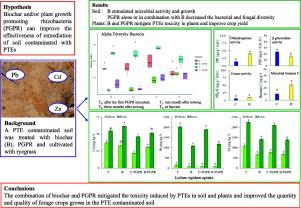Combining biochar, plant growth-promoting rhizobacteria, and annual ryegrass for the recovery of a PTEs multi-contaminated soil
IF 5
2区 农林科学
Q1 SOIL SCIENCE
引用次数: 0
Abstract
Phytoremediation is a sustainable, environmentally friendly and low-cost technology for the restoration of soils contaminated with potentially toxic elements (PTEs). We hypothesized that the effectiveness of the recovery process can be improved by associating phytoremediation with the application to the soil of amendments and/or the inoculum of plant growth-promoting rhizobacteria (PGPR). The aim of this study was therefore to assess the suitability of combining a new microbial consortium with biochar for the remediation of a soil contaminated with Cd (22.6 mg·kg−1), Pb (4473 mg kg−1) and Zn (3147 mg kg−1) and cultivated with annual ryegrass (Lolium rigidum). In the biochar treated-soil, the amounts of exchangeable PTEs were reduced by 56, 60 and 81 % for Cd, Pb and Zn respectively, compared to the untreated soil. Dehydrogenase and urease activities increased in the amended soil compared to the control, while β-glucosidase decreased in the presence of biochar. Soils treated with PGPR alone or in combination with biochar showed the lowest bacterial and fungal diversity, showing that the microbial inoculum was the main factor influencing the structure of the soil microbiota. The highest biomass production of ryegrass was detected in plants grown in soil treated with biochar and inoculated with PGPR (+31 % vs. control), suggesting a synergistic effect of the treatments in improving plants growth. A reduced PTEs uptake was also recorded in plants grown in soil treated with biochar and inoculated with PGPR. These results highlighted that PGPR significantly increased the effectiveness of biochar in the assisted phytoremediation.

结合生物炭、植物促生根瘤菌和一年生黑麦草修复pte多污染土壤
植物修复是一种可持续、环境友好、低成本的潜在有毒元素污染土壤修复技术。我们假设,通过将植物修复与土壤改良剂的应用和/或植物生长促进根瘤菌(PGPR)的接种联系起来,可以提高恢复过程的有效性。因此,本研究的目的是评估一种新的微生物组合与生物炭结合修复镉(22.6 mg·kg - 1)、铅(4473 mg kg - 1)和锌(3147 mg kg - 1)污染土壤并种植一年生黑麦草(Lolium rigidum)的适宜性。与未处理土壤相比,生物炭处理土壤中Cd、Pb和Zn的交换性pte分别减少了56%、60%和81%。与对照相比,改良土壤中脱氢酶和脲酶活性增加,而β-葡萄糖苷酶在生物炭的存在下降低。PGPR单独处理或与生物炭联合处理的土壤细菌和真菌多样性最低,表明微生物接种量是影响土壤微生物群结构的主要因素。在生物炭处理和接种PGPR的土壤中生长的黑麦草生物量最高(比对照增加31%),表明这两种处理在促进植物生长方面具有协同效应。在生物炭处理和接种PGPR的土壤中生长的植物也记录了pte吸收的减少。这些结果表明,PGPR显著提高了生物炭在植物修复中的有效性。
本文章由计算机程序翻译,如有差异,请以英文原文为准。
求助全文
约1分钟内获得全文
求助全文
来源期刊

Applied Soil Ecology
农林科学-土壤科学
CiteScore
9.70
自引率
4.20%
发文量
363
审稿时长
5.3 months
期刊介绍:
Applied Soil Ecology addresses the role of soil organisms and their interactions in relation to: sustainability and productivity, nutrient cycling and other soil processes, the maintenance of soil functions, the impact of human activities on soil ecosystems and bio(techno)logical control of soil-inhabiting pests, diseases and weeds.
 求助内容:
求助内容: 应助结果提醒方式:
应助结果提醒方式:


